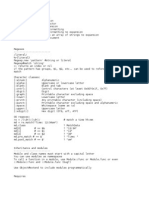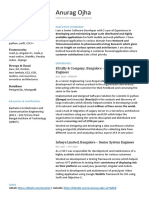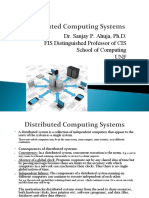0 ratings0% found this document useful (0 votes)
45 viewsIntroduction To Web Development
Uploaded by
川世宪Copyright
© © All Rights Reserved
We take content rights seriously. If you suspect this is your content, claim it here.
Available Formats
Download as TXT, PDF, TXT or read online on Scribd
0 ratings0% found this document useful (0 votes)
45 viewsIntroduction To Web Development
Uploaded by
川世宪Copyright
© © All Rights Reserved
We take content rights seriously. If you suspect this is your content, claim it here.
Available Formats
Download as TXT, PDF, TXT or read online on Scribd
You are on page 1/ 2
Introduction to Web Development
1. Understanding Web Development
Definition: Web development is the process of creating websites and web
applications for the internet or intranet.
Types of Web Development:
Front-End Development: Focuses on the client side, dealing with the visual aspects
of a website that users interact with.
Back-End Development: Involves server-side programming, managing databases, and
ensuring that the front end can interact with the server.
Full-Stack Development: A combination of both front-end and back-end development.
2. Key Technologies in Web Development
HTML (HyperText Markup Language): The standard markup language used to create web
pages.
Structure of HTML: Uses tags (e.g., <h1>, <p>, <div>) to define elements on a page.
CSS (Cascading Style Sheets): A stylesheet language used to describe the
presentation of HTML documents.
Styling Techniques: Fonts, colors, layouts, and responsive design using media
queries.
JavaScript: A programming language that enables interactive features on websites
(e.g., forms, animations).
DOM Manipulation: Changing the Document Object Model (DOM) using JavaScript to
update content dynamically.
3. Front-End Frameworks and Libraries
React: A JavaScript library for building user interfaces, developed by Facebook.
Vue.js: A progressive framework for building user interfaces, known for its
simplicity and flexibility.
Bootstrap: A CSS framework for developing responsive and mobile-first websites,
featuring pre-designed components.
4. Back-End Technologies
Server-Side Languages:
Node.js: JavaScript runtime for server-side programming.
Python: Often used with frameworks like Django or Flask.
PHP: A server-side scripting language commonly used for web development.
Databases:
SQL Databases: Relational databases such as MySQL and PostgreSQL.
NoSQL Databases: Non-relational databases like MongoDB, used for handling
unstructured data.
5. Web Servers and Hosting
Web Server: Software that serves web pages to clients (browsers). Common web
servers include Apache and Nginx.
Hosting: Providing server space and resources to make a website accessible on the
internet.
Types of Hosting: Shared hosting, VPS (Virtual Private Server), dedicated hosting,
and cloud hosting.
6. Version Control Systems
Git: A distributed version control system for tracking changes in code.
GitHub: A platform for hosting and sharing Git repositories, enabling collaboration
among developers.
7. Responsive Web Design
Definition: An approach to web design that makes web pages render well on various
devices and window or screen sizes.
Techniques:
Fluid Grids: Layouts that resize based on the size of the screen.
Media Queries: CSS rules that apply styles based on device characteristics (e.g.,
width, orientation).
8. Web Development Workflow
Planning: Defining the website's goals, target audience, and key features.
Design: Creating wireframes and prototypes to visualize the layout and user
experience.
Development: Writing HTML, CSS, and JavaScript code to build the website.
Testing: Conducting usability tests, debugging, and ensuring compatibility across
different browsers and devices.
Deployment: Launching the website to a live server for public access.
Maintenance: Updating content, fixing bugs, and improving features over time.
You might also like
- 0184.Z-Stack User's Guide For CC2530 ZigBee-PRO Network Processor - Sample ApplicationsNo ratings yet0184.Z-Stack User's Guide For CC2530 ZigBee-PRO Network Processor - Sample Applications74 pages
- summarized short notes on web developmentNo ratings yetsummarized short notes on web development4 pages
- The Comprehensive Guide To Web DevelopmentNo ratings yetThe Comprehensive Guide To Web Development6 pages
- Web Development and Divide Into 4 PartsNo ratings yetWeb Development and Divide Into 4 Parts22 pages
- Front-End and Back-End Development Farhan and AhmedNo ratings yetFront-End and Back-End Development Farhan and Ahmed20 pages
- Introduction To Web Development and DesignNo ratings yetIntroduction To Web Development and Design38 pages
- Online Training On Web Development - Build A Reponsive Website With HTML, CSS and BootstrapNo ratings yetOnline Training On Web Development - Build A Reponsive Website With HTML, CSS and Bootstrap11 pages
- Paper 1 - Introduction To Web DevelopmentNo ratings yetPaper 1 - Introduction To Web Development17 pages
- Sample Question Paper Mid-term Test 1 (2)No ratings yetSample Question Paper Mid-term Test 1 (2)39 pages
- Vantage App Note SDK Rest Int Guide V1.0No ratings yetVantage App Note SDK Rest Int Guide V1.036 pages
- Shubham Chhimpa Resume April2023 Without Number100% (1)Shubham Chhimpa Resume April2023 Without Number1 page
- VIPS OOPS Unit 3 Event Handling and ListenersNo ratings yetVIPS OOPS Unit 3 Event Handling and Listeners18 pages
- Computer Programming and Game Design With: Scratch100% (3)Computer Programming and Game Design With: Scratch48 pages
- Other Topics: (Combined (O-IT/ICT) - 2019)No ratings yetOther Topics: (Combined (O-IT/ICT) - 2019)4 pages
- Anurag Ojha: Eli Lilly & Company, Bangalore - Software Development EngineerNo ratings yetAnurag Ojha: Eli Lilly & Company, Bangalore - Software Development Engineer1 page
- Dr. Sanjay P. Ahuja, Ph.D. FIS Distinguished Professor of CIS School of Computing UNFNo ratings yetDr. Sanjay P. Ahuja, Ph.D. FIS Distinguished Professor of CIS School of Computing UNF14 pages
- GitHub - pazi88_Speeduino-M5x-PCBs_ Speeduino compatible m5x PnP PCBsNo ratings yetGitHub - pazi88_Speeduino-M5x-PCBs_ Speeduino compatible m5x PnP PCBs2 pages
- Vehicle Tracking System: International Journal of Scientific & Technology Research September 2021No ratings yetVehicle Tracking System: International Journal of Scientific & Technology Research September 20219 pages
- Setup Secured Connectivity To SAP Business One Mobile AppNo ratings yetSetup Secured Connectivity To SAP Business One Mobile App26 pages
- Sunil R Patel: Senior Software DeveloperNo ratings yetSunil R Patel: Senior Software Developer2 pages
- Bugreport Pissarro RP1A.200720.011 2021 12 30 08 53 42 Dumpstate - Log 18790No ratings yetBugreport Pissarro RP1A.200720.011 2021 12 30 08 53 42 Dumpstate - Log 1879039 pages

























































































